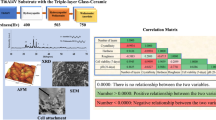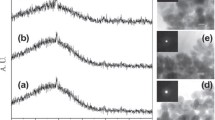Abstract
In this study, bioactive glass material containing sodium alginate was coated on the surface of Ti6Al4V alloy by the sol–gel method, and its bioactive property was investigated. The aim of the study is to make the surface of Ti6Al4V alloy bioactive with the help of the coating layer. For this purpose, polymeric coating functional new material with bioactive glass layer was formed. Combination of triethyl phosphate tetraethoxysilane, and calcium nitrate was used as phosphate, silica, and calcium sources to form the sol structure. Also, by adding polyvinylpyrrolidone to the bioactive glass coating solution, the rheological properties of the solution were optimized, which is an important factor in the formation of a homogeneous coating surface. Bioactive glasses were coated on the Ti6Al4V surface and then heat treatment was applied to the samples at the optimum temperature of 200 °C for half an hour. The X-ray diffraction (XRD) and Fourier transform infrared (FTIR) devices were used to identify the phases formed and detect the functional groups. The energy-dispersive X-ray spectroscopy, XRD, and FTIR analysis methods were used to determine the in vitro bioactive property of the heat-treated samples at 200 °C before and after contact with simulated body fluid. The transmission electron microscope, differential scanning calorimetry, and simultaneous thermal analysis methods were also used to characterize the coating materials. Providing the desired bioactivity together with the lower heat treatment temperature has added superiority to the formed original coatings.














Similar content being viewed by others
References
Mahlooji E, Atapour M, Labbaf S (2019) Electrophoretic deposition of Bioactive glass–Chitosan nanocomposite coatings on Ti-6Al-4V for orthopedic applications. Carbohydr Polym 226:115299. https://doi.org/10.1016/j.carbpol.2019.115299
Marques DM, Oliveira VDC, Souza MT, Zanotto ED, Issa JPM, Watanabe E (2020) Biomaterials for orthopedics: anti-biofilm activity of a new bioactive glass coating on titanium implants. Biofouling 36(2):234–244
Sergi R, Bellucci D, Cannillo V (2020) A comprehensive review of bioactive glass coatings: state of the art, challenges and future perspectives. Coatings 10:757. https://doi.org/10.3390/coatings10080757
Henao J, Poblano-Salas C, Monsalve M, Corona-Castuera J, Barceinas-Sanchez O (2019) Bio-active glass coatings manufactured by thermal spray: a status report. J Mater Res Technol 8:4965–4984. https://doi.org/10.1016/j.jmrt.2019.07.011
Costa RC, Souza JG, Cordeiro JM, Bertolini M, de Avila ED, Landers R, Rangel EC, Fortulan CA, Retamal-Valdes B, da Cruz NC (2020) Synthesis of bioactive glass-based coating by plasma electrolytic oxidation: untangling a new deposition pathway toward titanium implant surfaces. J Colloid Interface Sci. https://doi.org/10.1016/j.jcis.2020.06.102
Mokhtari H, Ghasemi Z, Kharaziha M, Karimzadeh F, Alihosseini F (2018) Chitosan-58S bioactive glass nanocomposite coatings on TiO2 nanotube: structural and biological properties. Appl Surf Sci 441:138–149. https://doi.org/10.1016/j.apsusc.2018.01.314
Harb SV, Bassous NJ, de Souza TA, Trentin A, Pulcinelli SH, Santilli CV, Webster TJ, Lobo AO, Hammer P (2020) Hydroxyapatite and β-TCP modified PMMA-TiO2 and PMMA-ZrO2 coatings for bioactive corrosion protection of Ti6Al4V implants. Mater Sci Eng C. https://doi.org/10.1016/j.msec.2020.111149
Matinmanesh A, Li Y, Clarkin O, Zalzal P, Schemitsch E, Towler M, Papini M (2017) Quantifying the mode II critical strain energy release rate of borate bioactive glass coatings on Ti6Al4V substrates. J Mech Behav Biomed Mater 75:212–221. https://doi.org/10.1016/j.jmbbm.2017.07.030
Ghosh S, Dandapat N, Balla V (2015) Preparation and in vitro characterization of fluroapatite based bioactive glass-ceramics for biomedical applications. Mater Today Proc 2:1326–1331. https://doi.org/10.1016/j.matpr.2015.07.050
Joy-anne NO, Su Y, Lu X, Kuo P-H, Du J, Zhu D (2019) Bioactive glass coatings on metallic implants for biomedical applications. Bioact Mater 4:261–270. https://doi.org/10.1016/j.bioactmat.2019.09.002
Su Y, Cockerill I, Zheng Y, Tang L, Qin Y-X, Zhu D (2019) Biofunctionalization of metallic implants by calcium phosphate coatings. Bioact Mater 4:196–206. https://doi.org/10.1016/j.bioactmat.2019.05.001
Beltrán AM, Begines B, Alcudia A, Rodríguez-Ortiz JA, Torres Y (2020) Biofunctional and tribomechanical behavior of porous titanium substrates coated with a bioactive glass bilayer (45S5–1393). ACS Appl Mater Interfaces 12:30170–30180. https://doi.org/10.1021/acsami.0c07318
Baino F, Hamzehlou S, Kargozar S (2018) Bioactive glasses: where are we and where are we going? J Funct Biomater 9:25. https://doi.org/10.3390/jfb9010025
Ferraris S, Yamaguchi S, Barbani N, Cristallini C, di Confiengo GG, Barberi J, Cazzola M, Miola M, Vernè E, Spriano S (2020) The mechanical and chemical stability of the interfaces in bioactive materials: the substrate-bioactive surface layer and hydroxyapatite-bioactive surface layer interfaces. Mater Sci Eng C. https://doi.org/10.1016/j.msec.2020.111238
Moghanian A, Zohourfazeli M, Tajer MHM (2020) The effect of zirconium content on in vitro bioactivity, biological behavior and antibacterial activity of sol-gel derived 58S bioactive glass. J Non-Cryst Sol 546:120262. https://doi.org/10.1016/j.jnoncrysol.2020.120262
Fu T, Alajmi Z, Shen Y, Wang L, Yang S, Zhang M (2017) Sol-gel preparation and properties of Ag-containing bioactive glass films on titanium. Int J Appl Ceram Technol 14:1117–1124. https://doi.org/10.1111/ijac.12713
Omar SA, Castro Y, Ballarre J, Schreiner WH, Durán A, Ceré SM (2017) Magnesium alloys implants coated with 58S sol-gel bioactive glass to retard first stage corrosion. Corrosion 73:1448–1460. https://doi.org/10.5006/2508
Mesquita-Guimarães J, Henriques B, Silva F (2018) Bioactive glass coatings. Bioactive Glasses. Elsevier, Amsterdam, pp 103–118. https://doi.org/10.1016/B978-0-08-100936-9.00007-1
Boccardi E, Liverani L, Boccaccini AR (2019) Bioactive behavior of mesoporous silica particle (MCM-41) coated bioactive glass-based scaffolds. Int J Appl Ceram Technol 16:1753–1761. https://doi.org/10.1111/ijac.13245
Kokubo T, Takadama H (2006) How useful is SBF in predicting in vivo bone bioactivity? Biomaterials 27:2907–2915. https://doi.org/10.1016/j.biomaterials.2006.01.017
Menci PF, Mari A, Charbonneau C, Lefebvre L-P, De Nardo L (2019) aging of bioactive glass-based foams: effects on structure, properties, and bioactivity. Materials 12:1485. https://doi.org/10.3390/ma12091485
Cordero-Arias L, Cabanas-Polo S, Goudouri O, Misra SK, Gilabert J, Valsami-Jones E, Sanchez E, Virtanen S, Boccaccini AR (2015) Electrophoretic deposition of ZnO/alginate and ZnO-bioactive glass/alginate composite coatings for antimicrobial applications. Mater Sci Eng C 55:137–144. https://doi.org/10.1016/j.msec.2015.05.034
Hatcher BM, Seegert CA, Brennan AB (2003) Polyvinylpyrrolidone modified bioactive glass fibers as tissue constructs: In vitro mesenchymal stem cell response. J Biomed Mater Res Part A Off J Soc Biomater, Jpn Soc Biomat Aust Soc Biomater Korean Soc Biomater 66(4):840–849
Chen J, Zeng L, Chen X, Liao T, Zheng J (2018) Preparation and characterization of bioactive glass tablets and evaluation of bioactivity and cytotoxicity in vitro. Bioact Mater 3:315–321. https://doi.org/10.1016/j.bioactmat.2017.11.004
Hench L (1994) Bioactive ceramics: theory and clinical applications. Bioceramics. Elsevier, Amsterdam, pp 3–14
Acknowledgements
This study was financially supported by Eskişehir Osmangazi University Scientific Research Project (Project Number: 2018 /15A207).
Author information
Authors and Affiliations
Corresponding author
Additional information
Publisher's Note
Springer Nature remains neutral with regard to jurisdictional claims in published maps and institutional affiliations.
Rights and permissions
About this article
Cite this article
Civan, L., Nurbas, M. Characterization of sodium alginate containing bioactive glass coatings prepared by sol–gel processing. Polym. Bull. 78, 6473–6491 (2021). https://doi.org/10.1007/s00289-020-03425-8
Received:
Revised:
Accepted:
Published:
Issue Date:
DOI: https://doi.org/10.1007/s00289-020-03425-8




